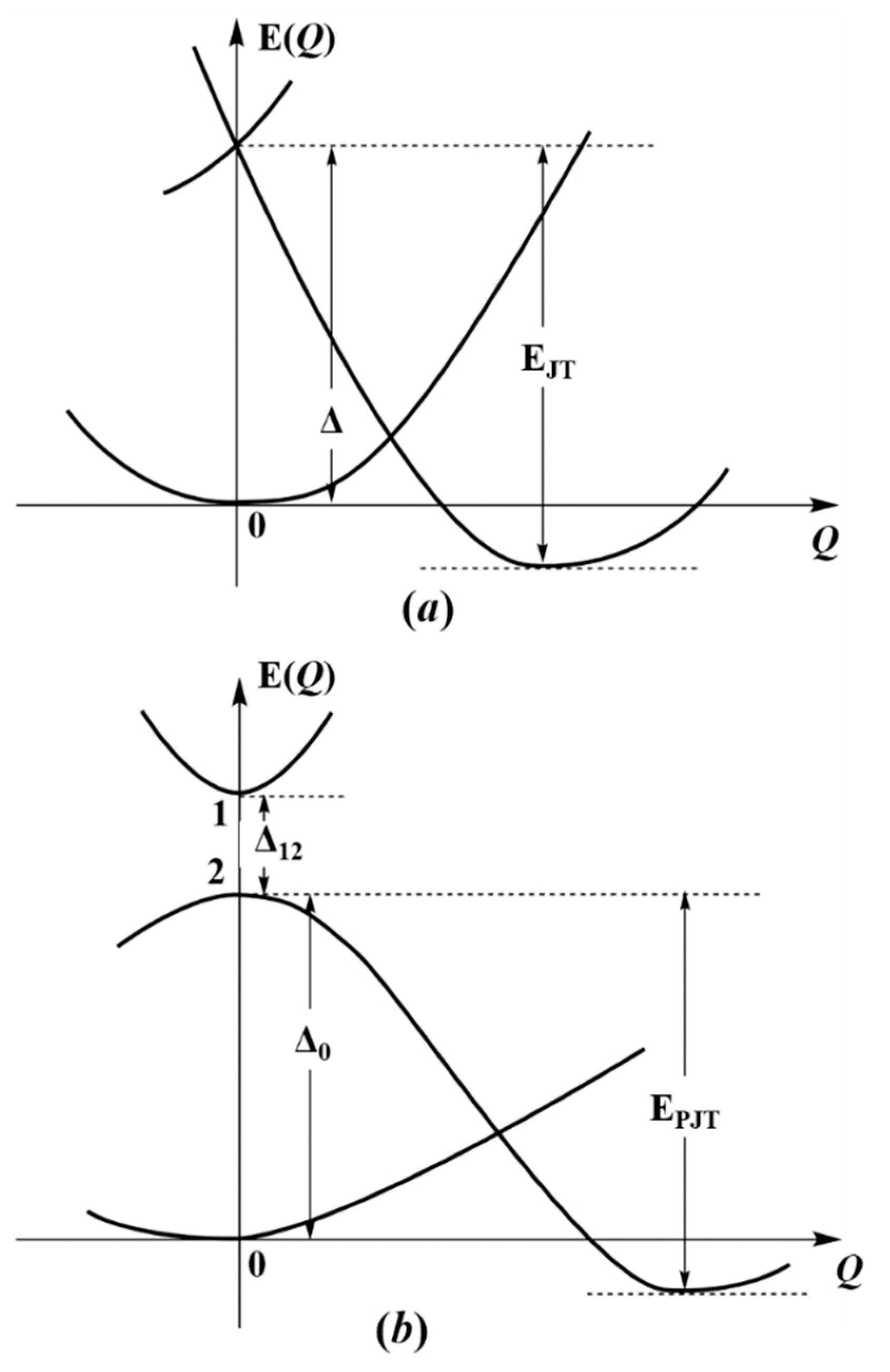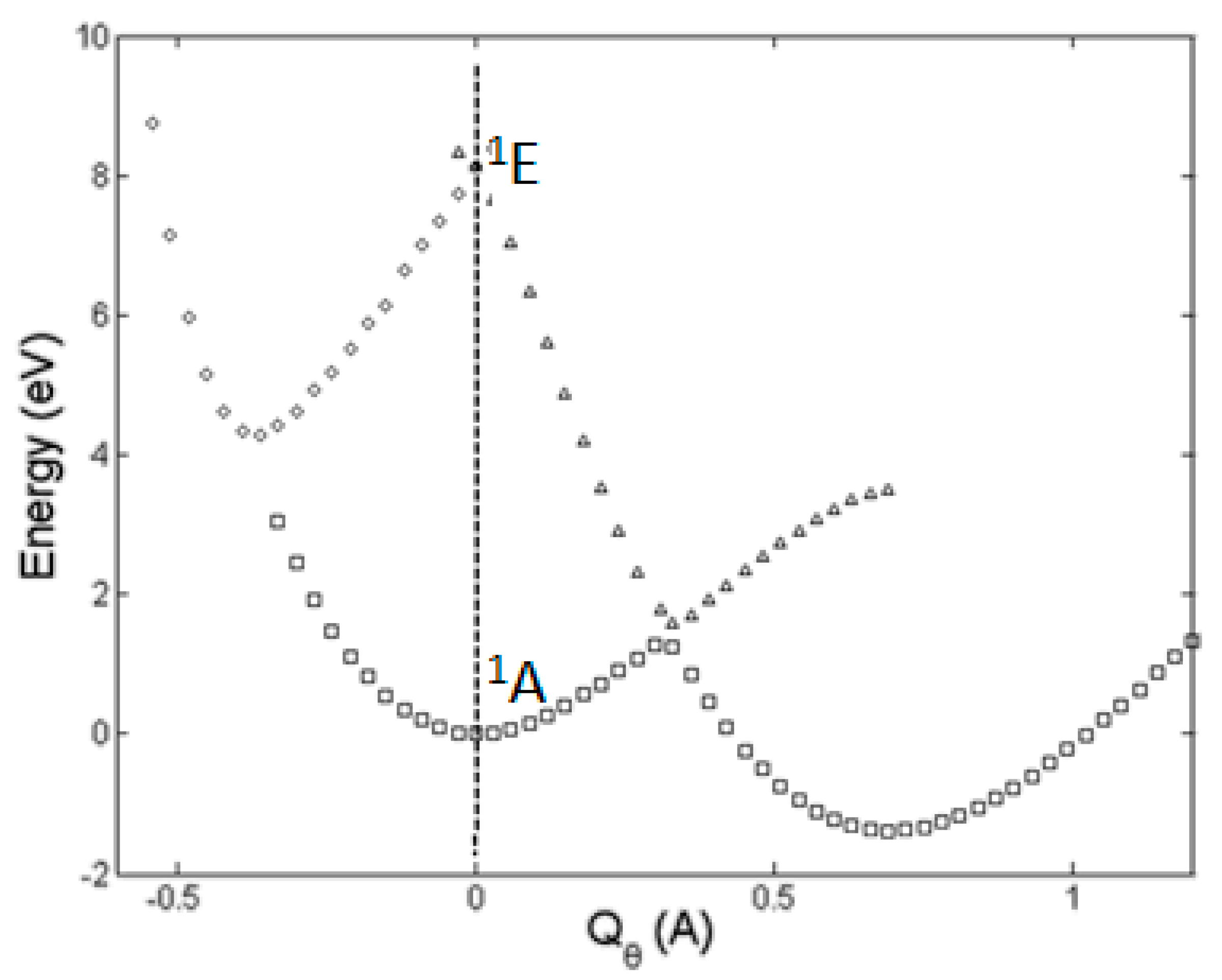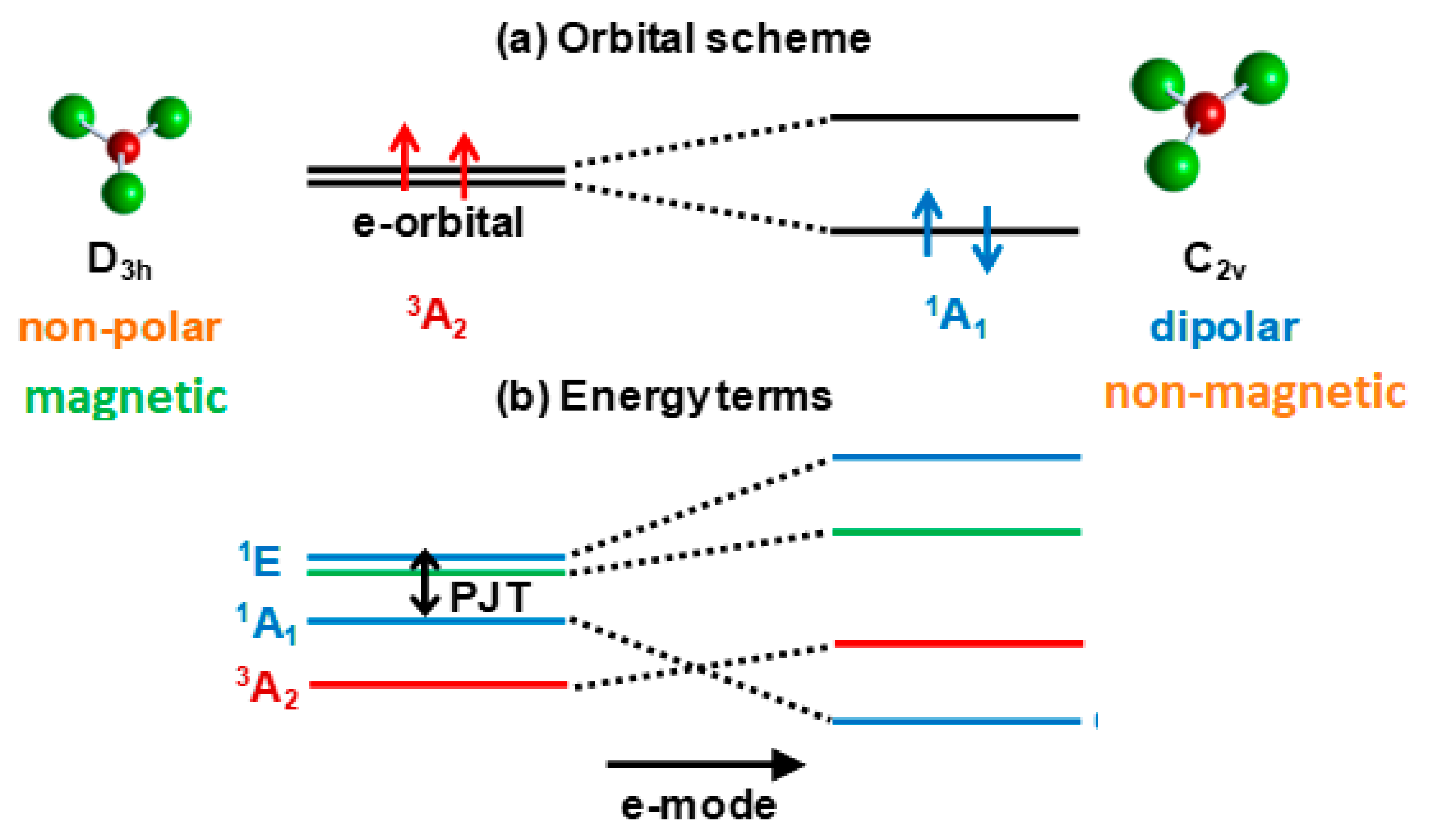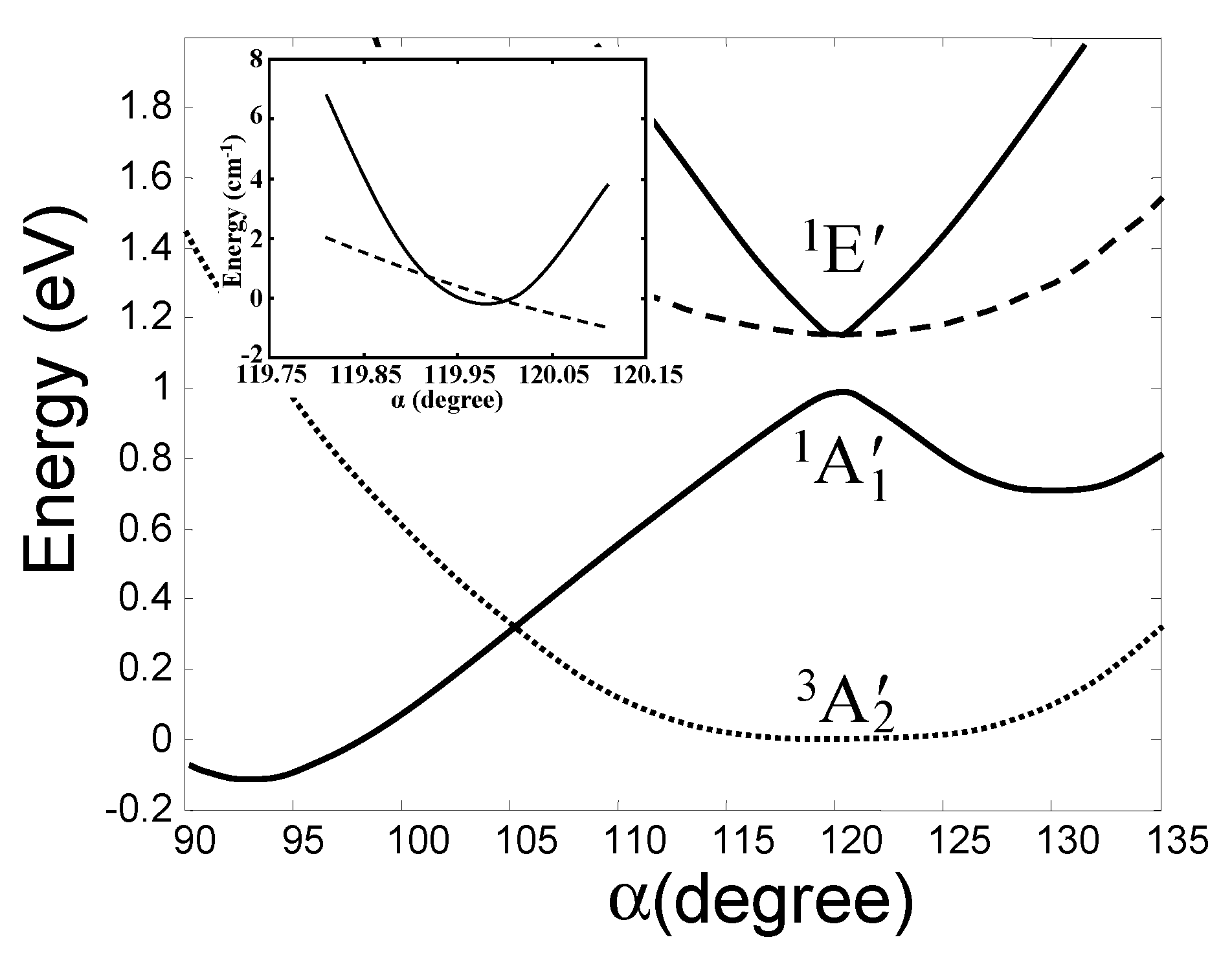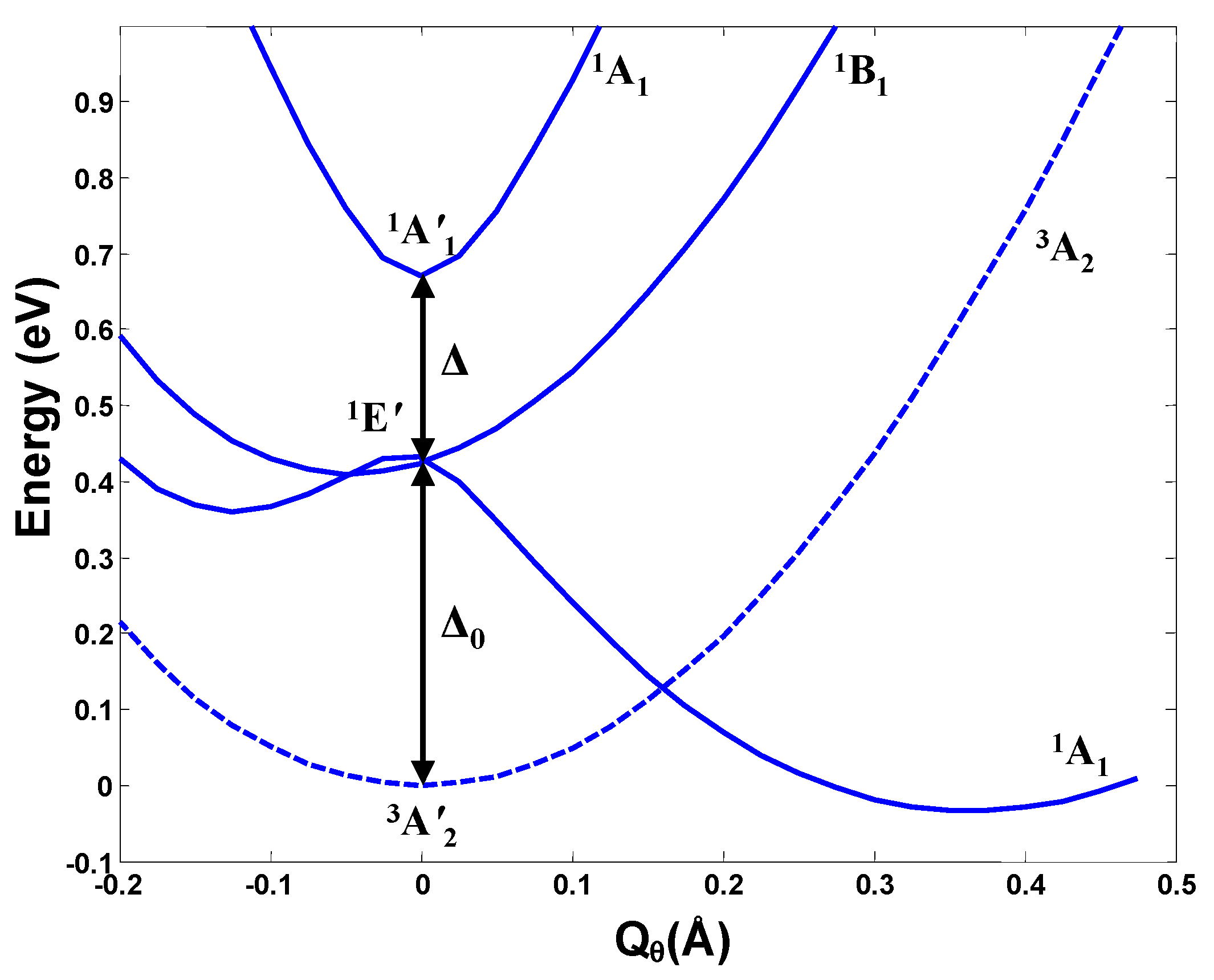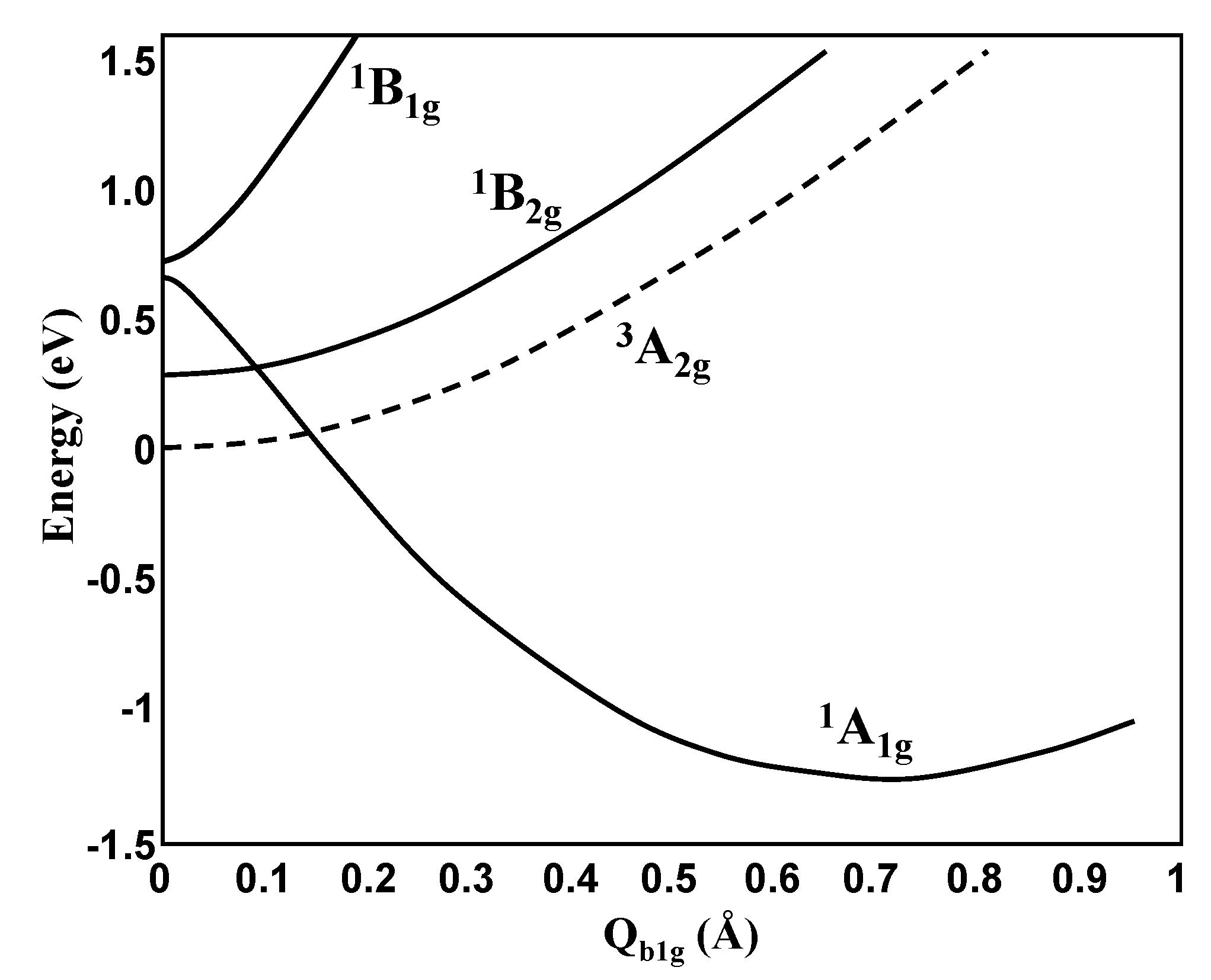1. Introduction
The interest in polyatomic systems with coexisting and switchable magnetic-dielectric bistability properties is very strong and increasing in view of their virtual role in going-on continuous innovations in electronics and spintronics. This semi-review paper incorporates previous and novel achievements of the theory of the Jahn–Teller effect (JTE) and pseudo-JTE [
1,
2,
3,
4,
5,
6] to show that there are many (whole classes of) molecular and solid-state systems with two or more coexisting stable configurations (separated by not very large energy barriers), among which some are magnetic, but nonpolar, the other being dipolar, but nonmagnetic, or they differ by the magnetic moment, with possible transitions between them under external perturbations, and they are all controlled by the recently discovered
hidden JTE or PJTE.
First, we notice that the two (or more) configurations in such bistability are different in the spin state, hence they cannot follow from the same electronic configuration of the system. On the other hand, the vibronic coupling in the Hamiltonian does not contain spin operators, meaning that neither the JTE, nor the PJTE may lead to the magnetic bistability under consideration: the equivalent minima of the multiminimum adiabatic potential energy surface (APES) produced by these effects have the same spin state. It follows that neither the JTE, nor the PJTE instability may lead to magnetic bistabilities. The prediction of the latter in such systems emerged only after the role of the so-called “hidden” JTE (
h-JTE) and “hidden” PJTE (
h-PJTE) was revealed [
4]. These hidden effects originate in the excited states of the system and, being sufficiently strong, they penetrate the ground state to form a coexisting stable configuration with the parameters of the excited state (
Section 2).
Obviously, the number of systems with possible
h-JTE or
h-PJTE is enumerable. We demonstrate it on the huge variety of systems with
half-filled closed-shell electronic configurations e2 and t3, where
e and
t are, respectively, twofold and threefold degenerate molecular orbitals, or bands in the solid state. They form a practically inexhaustible group of molecular (organic and inorganic) and solid state systems. In the ground state of such systems, according to Hund’s rule, the two electrons in the
e orbital and the three electrons in the
t orbital occupy, respectively, the two and the three orbitals (bands) with parallel spins, resulting in a totally-symmetric charge distribution with nonzero spin. In these cases the dipolar-distorted configurations occurs via the
h-PJTE due to orbital disproportionation [
5], when, for instance, the two electrons in the
e2 configuration are driven by the PJTE to occupy one of the two
e orbitals with antiparallel spins.
The definition and basic features of the
h-JTE and
h-PJTE are introduced in
Section 2, while the specific properties of systems with half-filled electronic shells of degenerate electronic configurations are outlined in
Section 3.
Section 4 considers in more detail magnetic-dielectric bistability of specific molecular systems.
Section 5 describes such bistability in solid states, with conclusions in
Section 6.
2. Hidden Jahn–Teller and Pseudo-Jahn–Teller Effects
First, we reiterate the obtained earlier conclusion that the JTE and the PJTE are the only source of instability and distortions of high-symmetry configurations of polyatomic systems [
1,
2,
3]. This important conclusion has been challenged by examples of molecular systems, which at face seem to contradict to its statement. Indeed, there are molecules in high-symmetry configurations, which are unstable in nondegenerate states (no JTE), with no appropriate excited state to induce the PJTE, e.g., when the excited states of appropriate symmetry are too high in energy or have a different spin multiplicity (see below). We have shown that in such cases the distortions are still due to the JTE or PJTE which originate in the excited states; but, being sufficiently strong, they penetrate the ground state [
4], producing additional lower (global) minima of the adiabatic potential energy surface (APES), in which the system is distorted. We call them ‘
hidden’ JTE and PJTE (
h-JTE and
h-PJTE, respectively) because they are not seen directly as a feature of degeneracy and pseudodegeneracy in the reference high-symmetry configuration; they appear only when the special role of an excited state is recovered.
Figure 1 illustrates this statement. We see that the ground state of the system is stable in the high-symmetry configuration at
Q = 0, but it is unstable in this configuration in the lowest excited double-degenerate state due to the JTE (
Figure 1a), or due to the pseudodegenerate interaction with a higher state in the PJTE (
Figure 1b). If these excited-state effects are sufficiently strong, their stabilization energies may offset the energy gap to the ground state (E
JT > Δ in the JTE or E
PJT > Δ in the PJTE case) and produce additional global minima, in which the equilibrium ground state is distorted [
4]. In case of the
h-JTE triggered by the E⊗e JTE problem in the excited state the additional configuration occurs when (
F2/2
K0) > Δ, where
F is the vibronic coupling constant, and
K0 is the primary force constant, while for the
h-PJTE the condition of a possible additional stable configuration is more complicated [
4],
where
is the constant of vibronic coupling between the two excite states, and the constants Δ
12 and Δ
0 are shown in
Figure 1b. In both cases,
h-JTE and
h-PJTE, under the above conditions, we get two stable configurations, distorted and undistorted, but distinguished from the JT case, where the possible distortions are restricted by the JT active modes, the PJT induced distortion may be of any kind, dependent on the symmetries of the mixing excited states. Another distinguished feature of the
h-PJTE is that it leads to orbital disproportionation discussed in
Section 3.
The
h-JTE was first demonstrated on the structure and properties of the ozone molecule O
3 [
7] for which ab initio calculations [
8,
9] show that in the high-symmetry regular-triangular geometry the ground state
1A is nondegenerate, and its excited double degenerate
1E state is rather high, at the energy gap Δ ~8.5 eV, so no JTE or PJTE is expected in the reference high-symmetry configuration. Nevertheless, the regular-triangular configuration of O
3 is not the ground-state one: its APES has lower-in-energy three equivalent minima, in which the configuration of the molecule is obtuse-triangular (with a nonzero dipole moment). The ab initio calculation of the cross section of the APES of this molecule along the distortion coordinate
Qθ, carried out including the ground
1A state and first excited
1E state [
7] follows the prediction of the theory for the
h-JTE: the three equivalent obtuse-triangular configurations with lower energy emerge from the E⊗e problem of the JTE in the excited
1E state, yielding a strong stabilization energy E
JT ~9 eV that penetrates the energy gap of ~8.5 eV (
Figure 2).
Note that in the case of the ozone molecule, both the ground state and the excited state responsible for the
h-JTE have the same spin state. Therefore, the two stable configurations—distorted and undistorted—have the same magnetic properties, hence the bistability in this case is simply dielectric: dipolar-nonpolar. However, if the two electronic states, participating in the hidden effects possess different spin states, the bistability would be both polar and magnetic. There are many such possibilities among polyatomic systems. Below we demonstrate this by the examples from
h-PJTE that incorporate a whole class of molecular systems and solids with possible bistabilities. There are also cases when both the
h-JTE and
h-PJTE take place simultaneously in the same system (see, e.g., the electronic structure of the CO
3 molecule [
10]).
3. Half-Filled Closed-Shell Degenerate Electronic Configurations with h-PJTE and Spin Crossover
With respect to the bistabilities discussed in this paper, the systems with half-filled closed-shell
e2 or
t3 electronic configurations, which occur in a wide range of molecular and solid-state systems, are of special interest. The JTE nature of possible distortions of the ground state of such systems is ad hoc most ‘hidden’ because their closed-shell charge distribution is totally symmetric. In addition, the ground states in these electronic configurations are no subjects of the PJTE either, since their excited states have a different spin multiplicity than that of the ground (Hund) state (see below). Nor can the ground state be formed by a strong JTE in the low-lying excited states (as in the O
3 case). Nevertheless, almost all of the
e2 and
t3 systems have distorted geometries in the ground state due to the
h-PJTE (
Figure 1b), which is especially pronounced in these cases.
Half-filled closed-shell electronic
e2 and
t3 configurations may occur in any molecular or solid-state system with at least one threefold (or higher) symmetry axis. For example, the Cu
3+ ion in octahedral environment in crystals and coordination systems has the configuration is (
t2g)
6e2 occupied by its eight
d-electrons, two in the outer
e2 configuration (
Section 5). The latter remains also in the in the D
3h symmetry of the CuF
3 molecule (
Section 4). The energy terms formed by the interelectron interactions in
e2 configurations is shown in
Figure 3. We see that in these cases the ground state of the undistorted configuration (triangular, octahedral, etc.) is a spin triplet,
3A
2, but a strong PJTE mixing of two excited singlet states,
1A
1 and
1E, may produce an additional lower-energy state with a distorted configuration (provided the stabilization energy E
PJT is larger than the energy gap Δ to the ground state, as in
Figure 1b). For a triangular system, the distorted configuration has a non-zero dipole moment, but a zero magnetic moment (zero spin from the
1A
1 state), whereas the undistorted configuration in the
3A
2 state has a zero dipole moment, but a nonzero magnetic moment.
The two different spin states of the two energy-minima configurations is a remarkable feature of systems with half-filled closed-shell
e2 and
t3 configurations. It is directly related to
orbital disproportionation [
5], when the triplet
3A state (formed by the mentioned above two electrons that occupy the two
e orbitals with parallel spins), which is expected to be the ground state according to the Hund’s rule, is overridden by the
1A state with zero spin (with two electrons with antiparallel spins in one
e orbital), the whole process being driven by the PJTE that lowers the energy.
Labeling the two
e functions by
ε and
θ and the two spin states by arrows up and down, we can present the wavefunctions of the excited singlet terms
1A1 and
1E before their PJTE mixing (
Figure 3) as
In all of these states, the charge distribution is symmetrical with respect to the
θ and
ε components. Due to the PJTE, the
1Eθ component mixes with the
1A
1 function to result in their linear combination, which in the case of sufficiently strong vibronic coupling produces a disproportionate distribution of either
or
[
5]
In either of these two cases, the charge distribution becomes non-totally symmetric and distorts the high-symmetry configuration of the system. In other words, if the
h-PJTE conditions are met, it is more energetically convenient for the system to pair its electrons on the same orbital and distort the nuclear framework than to remain symmetrical in either the ground or excited state of the undistorted configuration (the gain of energy due to the added covalency by the PJTE distortion [
1,
3] is larger than the loss due to higher interelectron repulsion in the violation of the Hund’s rule).
A quite similar effect takes place in the case of electron configuration
t3. In this case the interelectron interaction spans the states
,
,
, and
with the ground quadruplet state
4A2, which corresponds to the Hund’s rule distribution
. A strong PJTE coupling between the two excited states
2T1 and
2T2 results in a lower orbital disproportionate component of the type
with a doublet spin-state instead of the quadruplet in the high-symmetry configuration [
5].
As follows from these results, orbital disproportionation in systems with half-filled closed-shell electronic configurations is necessarily accompanied by lowering the spin of the electronic ground state. For the
e2 configuration it means transition from the high-spin (HS) triplet
3A state to the low-spin (LS) singlet state
1A, while for
t3 this transition is from the quadruplet (HS = 3/2) to the doublet (LS = 1/2) state. Since this transition is induced by the PJTE distortion originating from an excited electronic state, the two states, HS undistorted and LS distorted, coexist in two minima of the APES which may have close energies (
Figure 2). In between these two minima there is a crossing between the two states of different spin, a
spin crossover. The results of ab initio calculations in
Section 4 and
Section 5 show explicitly the spin crossover that takes place in the specific molecules and solids under consideration. It is demonstrated above to take place in molecular systems with electronic
e2 or
t3 configurations, meaning molecules with at least one three-fold axis of symmetry and appropriate number of electrons, as well as in solids with corresponding bands (
Section 5), but it may be expected in any systems with
h-JTE or
h-PJTE.
In the
e2 and
t3 systems the spin of the two nuclear configurations, distorted and undistorted, is different, with a higher spin in the undistorted configuration. This leads directly to magnetic moment
μ bistability (
μ1;
μ2). For
e2 systems the magnetic moment of the undistorted HS configuration with the spin S = 1 is
μ1 ≅ 2.82 MB, while for the distorted LS geometry S = 0 and
μ = 0, realizing a (2.82 MB; 0) magnetic bistability. On the other hand, the two geometries have different dielectric properties, e.g., dipole moments
p, leading to dipolar bistability (
p1;
p2). Often the distorted LS configuration has a non-zero dipole moment, whereas
p = 0 in the undistorted HS one, resulting in (0;
p) bistability. Thus, in such systems we have
two coexisting bistabilities, magnetic (2.82 MB; 0) and dipolar (0;
p), with interesting (and peculiar) properties of either magnetic moment, but no dipole moment in one of the coexisting states, or dipole moment, but no magnetic moment in the other state [
6]. Following the often-used terminology such systems can be termed
single-molecule multiferroics.
Another spin crossover {XE “spin crossover”} phenomenon is well known to take place in cubic coordination systems of transition metal compounds (TMC) with electronic configurations
d4-
d7 that may produce either HS or LS complexes, subject to the strength of the ligand field [
11,
12]. For some values of the latter the two electronic configurations, high-spin and low-spin, may be close in energy, so they can crossover as a function of the breathing mode of the system (involving the metal-ligand distance). This spin crossover is known for a long time, and has been subjected to intensive studies during more than three decades; systems with two spin-states may serve as molecular materials for electronics [
12]. However, the observation of the two states and transitions between them under perturbations (required for such materials) encounters essential difficulties because of fast radiationless transitions between them (very short lifetime of the higher in energy state due to its fast relaxation to the lower one). The two spin states in TMC cannot be observed beyond low temperatures because of their poor separation in space and fast relaxation due to the relatively high spin-orbital interaction in the metal [
12]. So far, they have been observed only for some compounds in optical LS
HS excitation at low temperatures <50 K and mostly as a cooperative effect in solids [
12].
The crossover induced by the
h-PJTE involving orbital disproportionation {XE “orbital disproportionation”} is essentially different from the spin crossover in TMC produced by the strength of the ligand field. Indeed, (1) the PJTE-induced spin crossover takes place in a variety of molecular systems, small to moderate, organic, and inorganic, as well as in metal-containing molecules, as illustrated below on a series of molecular systems taken as examples; (2) the HS—LS intersystem relaxation rate in the PJTE case is expected to be much lower than in TMC because the two spin states have different nuclear configurations, distorted and undistorted, producing a significant barrier between them and a small Franck–Condon factor, and the spin-orbital interaction in light-atom molecules is smaller by orders of magnitude than in TMC; (3) based on these considerations (followed by numerical estimates) it can be assumed that in the
h-PJTE-induced spin-crossover the switch between the two states (in both directions) under perturbations can be observed as a single-molecule phenomenon and at relatively higher temperatures. The ab initio calculations (
Section 4 and
Section 5) confirm the conclusions of the
h-PJTE theory.
4. Molecular Systems with h-PJTE-Induced Spin Crossover and Magnetic-Dielectric Bistability
In ab initio calculations of a series of molecular system, the main features of the outlined above
h-PJTE-induced bistabilities with spin crossover and switchable magnetic-dielectric properties were confirmed, and numerical estimates of the parameters were obtained [
6]. Consider first trivalent Cu compounds, for instance, the molecule CuF
3 or the local center in the crystal LiCuO
2 (see more in
Section 5). As mentioned above, in both systems with symmetries D
3h and O
h, respectively, the Cu
3+ ion has the valence electronic
d8 configuration, the outer two
d electrons of which occupy the
e orbitals forming the
e2 configuration. The latter produce the noted above three terms (
Figure 3), which in the D
3h symmetry of CuF
3 are labeled as
3A
2′ (ground state),
1A
1′, and
1E′. The results of full scale (high-level) ab initio calculations of all these terms in CuF
3 as a function of the
e type distortions (labeled by the angle α(F-Cu-F)) are shown in
Figure 4 [
6]. We see that, in accordance with the general theory, there is a strong PJTE interaction between the two excited
1A
1′, and
1E′ states, due to which the lower
1A
1′ state goes sharply down, crosses the HS triplet ground state of the undistorted configuration, and produces a global minimum with a distorted (α ≈ 93°) LS geometry. The difference between the zero point energies of these two configurations is 0.190 eV (all energies read-off the zero-point vibrational levels), while their excitation energies to the point of spin crossover (barrier heights) are δ
HS = 0.541 eV and δ
LS = 0.712 eV, respectively. In the distorted configuration the magnetic moment
μ = 0 and the dipole moment
p = 1.67 D, and in the undistorted state, as mentioned above,
μ = 2.82 MB with
p = 0. We thus get a perfect case of bistability, (2.82 MB, 0) vs. (0, 1.67 D), in which the two stable configurations are separated by both potential and magnetic (spin) barriers.
In another example of
e2-molecules, triangular Si
3 (
Figure 5) the energy terms, as expected, follow the energy level scheme in
Figure 3, leading to the
h-PJTE-induced two coexisting configurations with magnetic-dielectric bistability. It is similar to the CuF
3 case, but with a lower potential barrier between the two configurations. On the contrary, for square-planar Si
4 the potential barrier between the two coexisting configurations created by the
h-PJTE is very high (
Figure 6).
Calculations for possible bistabilities in systems with electronic
e2 configurations were also performed for clusters Ge
4, C
4H
4, CuO
6 (for the latter see
Section 5), etc.
Table 1 lists the estimated parameters of interest for these systems [
6]. The coordinates Q
a1 (totally symmetric), Q
ϑ and Q
ε (
e-type) describe the symmetrized displacements of the system in the distorted configurations (read-off the undistorted one), while β is the energy barrier between them, read off the zero-point vibrations, and τ is the lifetime of the higher energy configuration in relaxation to the lower one via spin-orbital coupling and thermalization.
The data for τ in this table were obtained by employing an approach [
11,
12], which starts from the time-dependent Schrödinger equation and follows the evolution of the system in the presence of a dissipation factor, that describes the thermalization time of the vibrational levels of the system in the singlet state, and estimating the temperature dependence of τ by summation of the contribution of all the Boltzmann populated ones. The numerical estimates obtained in this way are strongly dependent on the influence of the environment of the cluster, which varies significantly. Being rather approximate, these data may be taken into account as a first view on the subject, which shows that, as expected, τ is the largest in clusters with solid state environment, and for free molecules it is the largest in Ge
4. Si
3 has the shortest lifetime (comparable to that of most TMC systems), which increases in systems with larger distortions, and reaches macroscopic values in Si
4, Ge
4, and LiCuO
2 at low temperatures (but in Ge
4 there are low-lying triplet excited states that may reduce the lifetime). In the crystals, LiCuO
2 and NaCuO
2 (
Section 5), the estimates of the lifetime of the HS configuration are carried out for a separate cluster unit CuO
6; it is extremely large at low temperatures (due to the large distortions in the diamagnetic phase) and remains macroscopic at room temperature. Since the cooperative interactions between the complexes in the condensed phases obviously increase the lifetimes, the values in
Table 1 show the lower limit of the expected lifetimes. This means that the crystals LiCuO
2 and NaCuO
2 are quite feasible for practical use as bistability materials, and their long lifetime of both states in this bistability indicates that they can be used in the form of clusters, quantum dots, or thin films.
Note that, distinguished from the case of TMC crossover, where the two configurations are displaced along just the totally symmetric coordinate, the relaxation between the two configurations in the bistability under consideration is strongly reduced because of their different symmetry, distorted and undistorted, and the spin-orbital coupling is much lower in the light atoms than in transition metal compounds.
As a demonstration of the
t3 half-filed closed-shell
h-PJTE-induced magnetic-dielectric bistability we show here examples from two different kinds of molecular systems: Na
4− and C
603− [
6]. In the Na
4− cluster in the high-symmetry configuration the four sodium atoms are arranged in a tetrahedron. The four 3s valence orbitals in this conformation form
a1 and
t2 symmetrized orbitals with the electronic configuration is
a12t23 producing electronic terms
,
,
, and
(from the
t23 configuration). The complete active space self-consistent (CASSCF) calculations of the electronic structure of this system in the ground and excited states as a function of the tetragonal
e displacements using the
cc-
pvtz basis set and the
s valence orbitals of Na as the active space are illustrated in
Figure 7 [
6].
As expected from the general theory [
5], there is no significant JTE distortions in any of the states formed by the
t23 configuration, but there is a strong PJTE of the type (
2T1 + 2T2)⊗
e that pushes down one of the components of the
2T2 term making it the absolute minimum in which the tetrahedron is distorted in the
e direction. We have thus a spin-quadruplet ground state in the undistorted tetrahedral configuration and a spin-doublet state in the distorted global minimum with the shape of a rhombus. Although the energies of the two minima of the APES in this case are very close, the energy barrier between them is rather high, β ~3000 cm
−1 [
6].
For the
t1u3 configuration in the fullerene anions C
603− the orbital disproportionation was first revealed by direct estimation of the electron interactions in the distorted configuration in order to explain the origin of conductivity in the alkaline doped fullerides A
3C
60 [
13,
14]. In this case the PJTE problem is (
Hu +
T1u)⊗
hg, and there are many modes of
hg symmetry that contribute to the distortion of the fullerene molecule [
15]. Hence the problem is a multimode one [
1,
2,
16], and the solution in
Figure 8 is shown along the effective mode (often called “interaction mode” [
1,
2]).
5. Magnetic-Dielectric Bistability in Solid States Induced by h-PJTE
Half-filled closed-shell local formations in solid states may be even more important in applications because of their larger variety and better parameters. They include virtually all the cubic symmetry coordination compounds, ionic crystals, and impurity centers in crystals containing transition metal ions with the electronic configuration
e2 (
d8 ions in octahedral coordination and
d2 ions in tetrahedral or cubic environment), and
t3 (
d3 in octahedral and
d7 in tetrahedral coordination), as well as any other systems with
h-JTE or
h-PJTE involving an excited state with different multiplicity. Remarkably, the transition metal systems considered below are not the same as the mentioned above transition metal spin crossover ones. Experimentally, there is evidence of magnetic bistability in Ni
2+(
d8) complexes, in which a reversible equilibrium between octahedral magnetic and square-planar diamagnetic complexes has been observed [
17].
Electronic structure calculations for two solids from this class of compounds, the crystals LiCuO
2 and NaCuO
2 were carried out in the DFT-calculations with the hybrid B1WC functional [
6]. The structure of these crystals is formed by alternating layers of vertex-sharing Cu
3+(O
2−)
6 octahedrons and Li
+ or Na
+ ions, respectively. The Cu
3+ ion has a (
d8)
e2 electronic configuration (as mentioned above,
e denotes molecular orbital or symmetrized band states).
As predicted by the general theory and shown above for molecular cases, the HS configuration of these crystals is undistorted, while the LS state is diamagnetic with a very strong elongation of the CuO
6 octahedrons. The LiCuO
2 and NaCuO
2 crystal structures were optimized in both the HS (ferromagnetic and antiferromagnetic) and LS (diamagnetic) states [
6]. A summary of the numerical results is shown in
Table 2. As expected, the ferromagnetic and antiferromagnetic phases have very similar geometries with regular octahedral coordination of the oxygen atoms around Cu, whereas the diamagnetic phase is strongly distorted to almost square-planar coordination: in LiCuO
2 the metal-ligand distance in the magnetic phase is 2.01 Å, while in the diamagnetic phase the equatorial and axial ligands are at 1.86 Å and 2.76 Å, respectively (
Figure 9). In NaCuO
2 the same pattern is found, although the lattice parameter and distortions are by about 10% larger than in LiCuO
2. The results obtained for the geometry of the diamagnetic phase of these crystals agree well (within 2%) with the experimental data [
18,
19]; the interatomic distance changes are here 3–4 times larger than in TMC crossover systems.
The magnetic to diamagnetic phase transition has a strong repercussion on the crystal structure along the c-axis enlarging the unit cell by ~10% (≈0.5 Å) but the geometrical difference between the two bistability states does not translate in a large energy difference between them. Indeed, as shown in
Table 2 and
Figure 9 the energy difference between the phases is only of a few hundred cm
−1. In the case of LiCuO
2 the calculations yield that the magnetic phase (at the minimum of the APES) is lower by 150 cm
−1 than the diamagnetic one, but with the vibrational zero-point-energy correction the two phases are almost degenerate. In NaCuO
2 the non-magnetic phase is more stable. Due to these small energy differences between the phases it should be relatively easy to trigger a phase transition between them by external perturbation. Indeed, for LiCuO
2 a phase transition is observed at T = 180 K [
20]. For NaCuO
2 the ab initio calculations show that a diamagnetic to magnetic phase transition is achievable at a pressure of ~6 GPa [
6].
Following the results of
Section 3, the distortion of the high-symmetry (magnetic) configuration toward the diamagnetic one by the PJTE in two excited states is accompanied by orbital disproportionation [
5], due to which the two electrons in two e orbitals with parallel spins (and symmetric charge distribution) prefer to occupy one orbital with anti-parallel spins lowering the symmetry of the system, but gaining additional covalent metal-ligand bonding. This explains also the insulating properties of the diamagnetic NaCuO
2 or LiCuO
2 crystals that are subject to discussion in the literature [
21]: the orbital disproportionation splits the two-fold degenerate
e level or band (3z
2-r
2 and x
2-y
2 of Cu) and fully occupies the lower one.
